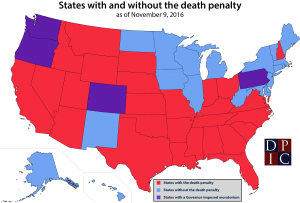“The punishment of execution, administered to someone legally convicted of a capital crime” (Oxford).
The first known execution in the New World was in 1608 when Captain George Kendall was put to death in Jamestown, VA after being accused of spying (Barbour). With this first execution came the beginning of a protracted and complicated relationship between America and capital punishment. By examining the history of the death penalty in the U.S. one can understand how an institution many consider archaic has persisted to present day. The death penalty has found its foundation in the historical significance of states’ rights and their implementation in the Constitution as well as the orientations of the Supreme Court.
The structure of the American federal system enumerates a large amount of power to the states, allowing each to make choices about what criminal policies to adopt. This makes it difficult for a wholesale repeal of the death penalty, and therefore contributes to its existence today. Because the U.S. Constitution designates that each state will have its own criminal laws and processes, imposition of capital punishment varies by state, not nationally. “A nationwide abolition of capital punishment would require not one comprehensive act of abolition (as occurred in other nations) but 52 distinct acts,” in the form of all fifty states, the federal government and the U.S. military (Garland). This explains why some states outlawed the death penalty hundreds of years ago while others still execute dozens of prisoners every year.

Source: https://deathpenaltyinfo.org/states-and-without-death-penalty
The Supreme Court is the only body with the capability to unilaterally decide the fate of the death penalty, but has been too divided ideologically to eradicate a punishment many people consider to be. With four liberal justices, four conservative justices and a centrist, any resolution, especially without serious division, is unlikely.

Source: https://wtop.com/national/2018/01/a-list-of-the-justices-of-the-supreme-court/
The death penalty is a controversial legal, social and political topic with literal life and death implications. Events are the products of their historical context, and the introduction and continuation of the death penalty is no exception. The structure of the U.S. federal system has the implications of allowing states their own laws and setting election patterns, both of which cause a stagnation in any eradication of the death penalty. The nature of the Supreme Court and its members also explain why America has preserved the death penalty. However, mounting concerns about the effectiveness and ethics of capital punishment have shifted sentiments and led to a greater anti-death penalty voice. It is now incumbent upon Americans to abandon this practice and elect for punishments that are less cruel and more effective.
The arguments in this blog rest on the basic premise that human life is valuable, and that America is responsible for correcting practices that fail to serve its aims or represent its values. Capital punishment is a life and death issue, and even were it not it would still betray our identity as a society and violate the social contract between our democracy and the people it serves.
